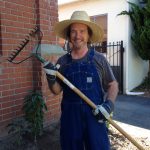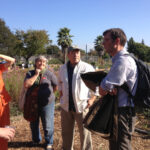An example of change-making
I’m Joanne Poyourow, I use the pronouns she/hers, and I’m a change-maker. Back in 2005 I co-founded the Environmental Change-Makers community group in Los Angeles with Peter Rood. I’m an economist by training, and I was a Certified Public Accountant in public practice for a long while — but for the most part, that’s not what I’m here to share with you.
Back in 2000 or so, while I was nursing my baby daughter, that I picked up a book on global warming. It was the first time I’d ever heard about this. Wow, I said, What kind of world have I brought this baby into? Then my second thought was: Well, there’s got to be something we can do about it. So I started researching what we could do. I found lots of solutions that people were already working on. When I told my friends about all these amazing solutions, they said, “You should write a book about this.”
So I started to write a book. But early on I realized: Who needs yet another nonfiction book of lists of things we should do? So I decided to tell a story instead. I wrote a novel. In that novel, I imagined a group where activists came together and supported each other. One character worked on solving problems with trash, another character grew urban vegetables, and yet another one worked on international climate treaties — all facets of the problem. Meanwhile, they all cheered each other on. And my friends said: “Wow, we want to belong to that group!”
That’s how we started the Environmental Change-Makers. From the very beginning we decided to make it a different kind of group, one that focused on positive solutions, “what we can do.”
That was long before there was an Oscar-winning movie like An Inconvenient Truth. Mentioning global warming was more likely to get you an argument about whether it existed, rather than any serious discussion about what we could do. Still our little group kept going.
At the beginning of each month’s meeting we’d ask: What have you done this month? “I set up my composter,” someone said. “I remembered to take my canvas bags to the grocery store,” said someone else. And we’d give them a round of applause. Where do you get applause for doing this kind of stuff? We were the place.
We brought in speakers about solutions. Over the years, sometimes famous ones. We taught food gardening classes. We held hands-on workshops, like Building Solar Cookers, or Cluck Trek, a tour of local urban chicken coops.
In 2008 we got involved in the international Transition Movement. We hosted the very first Transition Trainings in Southern California, drawing participants from throughout the Western states.
For a while we ran the Transition Los Angeles city hub, which at one point coordinated eight local Transition groups.
All this time, we’d been meeting in the community hall of the little church where Peter was the pastor. Our change-makers group included all kinds of people from many walks of life—a few from the church, but mostly not—and sometimes we affectionately called the church hall our “clubhouse.”
After hearing me quote the Permaculture Principle “Obtain a yield” many times, Peter announced that he was turning a part of the church grounds into a food garden. He wanted to grow food for the local food bank. “Who’s going to run it?” I asked. Oh. I get it. So for the next 11 years, I did.
We built the Community Garden at Holy Nativity based on Permaculture design. We included lots of aspects of sustainability. We set up on-site composting — of the garden trimmings, plus all the food scraps from all the various groups that used the site, it was quite a project coordinating that!
Eventually we added rainwater harvesting features. We planted more than 25 fruit trees. We built a community-scale wood-fired bread-and-pizza oven which was open to the public each month. All on an urban lot, a public street corner in the City of Los Angeles. The Garden itself was open to the public 24/7/365. There were no gates, no barriers. It became an example to the community. And we harvested food for the local food pantry nearly every single week of those 11 years.
While all this was going on, a teacher came to us from the local middle school, named Paula Cohen. Paula said: “Could you help me build a garden on the school site? We have an acre of open land.” We jumped at the chance.
It took 3 years of negotiations with Los Angeles Unified School District to gain the use of their land. In 2011 we broke ground on the Emerson Avenue Community Garden. I designed it as a combination school garden, traditional plot-style community garden, and community pocket park. Eventually we formed a nonprofit and a Board, and the Garden continues today.
Along the way, the Environmental Change-Makers were involved in political action too. We hosted local actions for 350.org climate campaigns. We attempted to make the City of Los Angeles into a “GMO-free zone.”
Not all of our ventures were successes. You never have a perfect score. But the important thing is: we tried stuff. We got out there and did stuff. And the things we did made a difference: they stuck in people’s memories, they touched people’s hearts, they tapped into their dreams for a better life, a better world. It brought people together, and together we brought those dreams and ideas alive.
I’ve also written a few books about these experiences. I’ve co-taught a course at Otis College of Art & Design about all that I’ve learned along the way — about community-building, about positive action, about sustainable solutions. And during covid times, I turned that course into the “What We Can Do” series.
So that’s just a taste of the things we’ve done.


